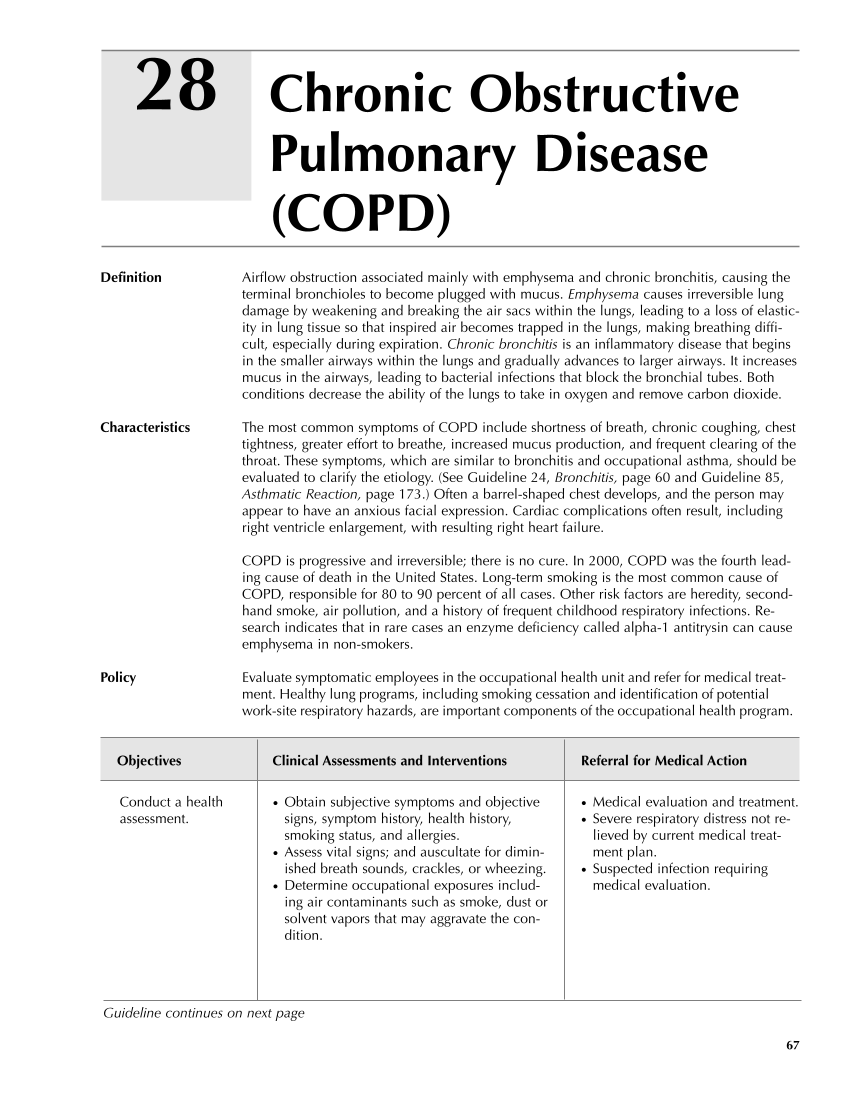67 Chronic Obstructive Pulmonary Disease (COPD) 28 Definition Airflow obstruction associated mainly with emphysema and chronic bronchitis, causing the terminal bronchioles to become plugged with mucus. Emphysema causes irreversible lung damage by weakening and breaking the air sacs within the lungs, leading to a loss of elastic- ity in lung tissue so that inspired air becomes trapped in the lungs, making breathing diffi- cult, especially during expiration. Chronic bronchitis is an inflammatory disease that begins in the smaller airways within the lungs and gradually advances to larger airways. It increases mucus in the airways, leading to bacterial infections that block the bronchial tubes. Both conditions decrease the ability of the lungs to take in oxygen and remove carbon dioxide. Characteristics The most common symptoms of COPD include shortness of breath, chronic coughing, chest tightness, greater effort to breathe, increased mucus production, and frequent clearing of the throat. These symptoms, which are similar to bronchitis and occupational asthma, should be evaluated to clarify the etiology. (See Guideline 24, Bronchitis, page 60 and Guideline 85, Asthmatic Reaction, page 173.) Often a barrel-shaped chest develops, and the person may appear to have an anxious facial expression. Cardiac complications often result, including right ventricle enlargement, with resulting right heart failure. COPD is progressive and irreversible there is no cure. In 2000, COPD was the fourth lead- ing cause of death in the United States. Long-term smoking is the most common cause of COPD, responsible for 80 to 90 percent of all cases. Other risk factors are heredity, second- hand smoke, air pollution, and a history of frequent childhood respiratory infections. Re- search indicates that in rare cases an enzyme deficiency called alpha-1 antitrysin can cause emphysema in non-smokers. Policy Evaluate symptomatic employees in the occupational health unit and refer for medical treat- ment. Healthy lung programs, including smoking cessation and identification of potential work-site respiratory hazards, are important components of the occupational health program. Objectives Clinical Assessments and Interventions Referral for Medical Action ● Medical evaluation and treatment. ● Severe respiratory distress not re- lieved by current medical treat- ment plan. ● Suspected infection requiring medical evaluation. Conduct a health assessment. ● Obtain subjective symptoms and objective signs, symptom history, health history, smoking status, and allergies. ● Assess vital signs and auscultate for dimin- ished breath sounds, crackles, or wheezing. ● Determine occupational exposures includ- ing air contaminants such as smoke, dust or solvent vapors that may aggravate the con- dition. Guideline continues on next page
Purchased from OEM Press by (ge corporate access). (C) 2013 OEM Health Information, Inc. All rights reserved.












































































































































































































































































































































































































































